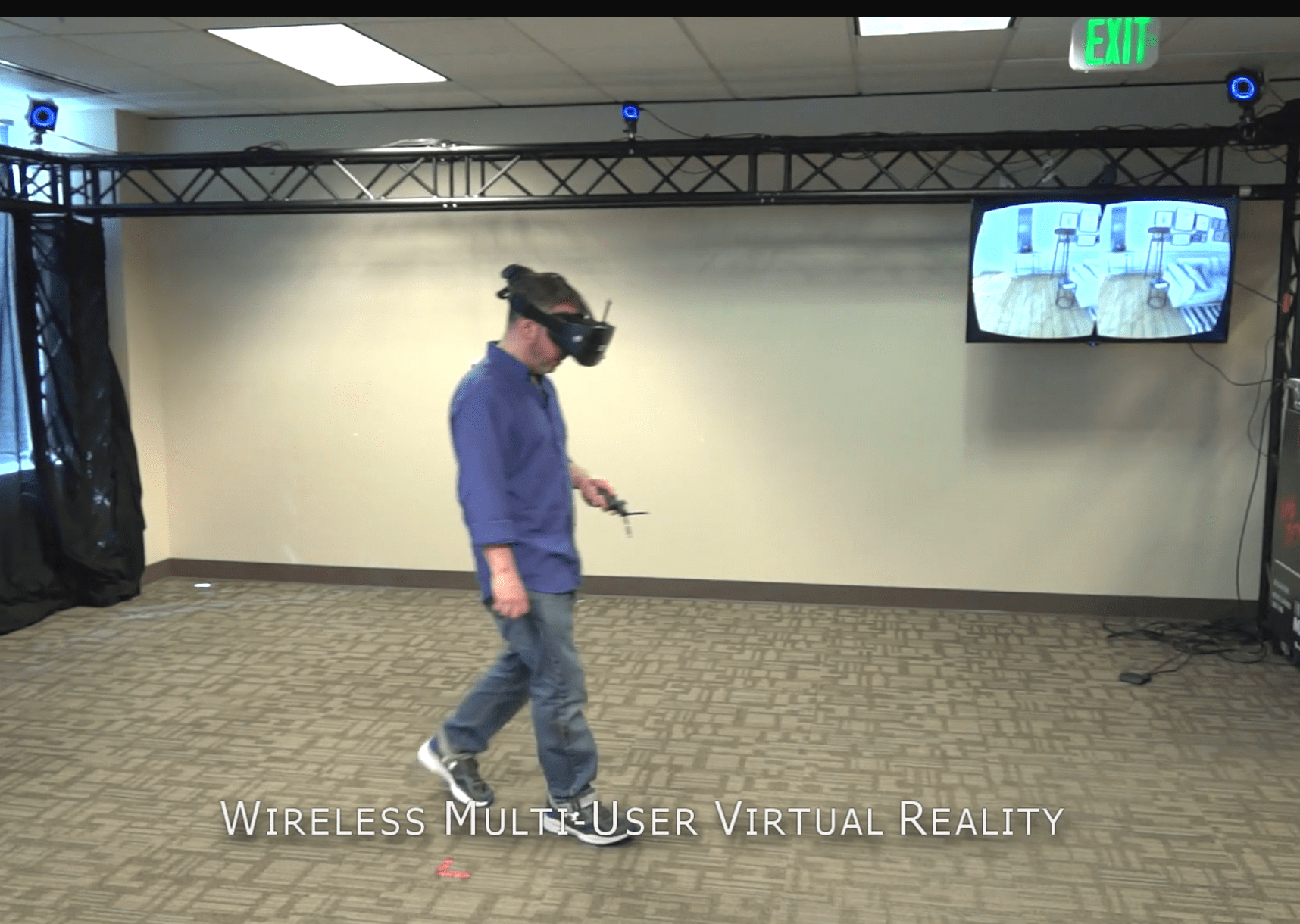Virtual reality is assumed to be a gaming technology and most people expect it to be proven first with game enthusiasts. But the real economic opportunity for VR lies in the enterprise and local engagement with customers, who will be able to step inside a computer-generated space to examine architectural plans, and employees who receive training in complex situations. At least, that’s the impression I came away with after visit to VR Studios’ office in Bellevue, Washington.
VRStudios constructs immersive spaces, a stage if you will into which the user steps wearing a wireless headset and armed with a pointing device that can double as a gun in first-person shooter settings. The stage is surrounded by a framework of PVC supported cameras that track the person in the virtual space, allowing them to walk freely from place to place in a way reminiscent of Star Trek: The Next Generation‘s Holodeck. Multiple people can wander in the VR space, each seeing what they would expect from their vantage point.
The company raised another $3 million in funding this past week, after announcing earlier in April that its technology will support the first immersive theme park, being built by Dubai-based Meraas Holdings. I saw a zombie shooter game, which the staff used between visitors, played with sweaty gusto.
Take a look at the VRStudios experience in this company video.
Having used the system, I can tell the experience is extraordinary, as VRStudios is taking great care to develop lifelike worlds, focusing on little things such as how the light reflects in windows and skylights at different times of the day. But there are many potential improvements in the in-world experience that improved rendering and developer time on greater detail will address. We are at the very beginning of this industry and it wouldn’t be reasonable to say that the lack of complete verisimulatude with the real world is necessary or expected now.
As discussed in the video, the enterprise uses of this type of VR, without wires and built on a powerful computing platform dedicated to rendering the VR environment, can be used in architectural firms and aerospace companies, for example, to provide tours of buildings or airplane designs before they are built. One Seattle architectural company saved approximately $500,000 in building mistakes by walking their client through the simulated finished design and discovering that a staircase, had it beeen built as designed, would have had to be moved at significant cost after construction.
Training simulations, too, are an obvious use for immersive VR, as well as local marketing. One major homebuilder is creating a $1-million design center for its new home developments to allow homebuyers to tour and design their homes before they buy. Hiring an immersive world simulation, as the military often does to prepare soldiers, could be offered to employees and contractors alike as an entertaining way to prepare to deliver better service to customers, or how to deal with unexpected events when working.
A busy architect may be able to keep a VRStudios installation busy much of the day, but the likelihood is that any business will only use such a facility infrequently. Consequently, the growth of immersive VR will be dependent upon developing facilities that can be utilized by multiple customers all-day during a day or week; weekends may see the stage used purely for entertainment.
These facilities will be shared and managed to maximize revenue. But that also suggests they will be seeking commercial uses by brands seeking to provide exciting customer engagments locally. I can imagine a Tesla showroom filled with as-yet built Model 3s offered in local VR facility, perhaps installed at a mall. Because the system will soon be able to support virtual presence, a space shared by multiple remote users, a new class of meeting and event experience is also possible.
Local business should not be discounting VR as a tool for selling. A VR experience is the ideal “pop-up” retail experience, for example. Training uses can be offered to local workers, even on-demand contractors, as an entertaining way to learn to do a better job as a service provider.
In every way, VR and, to an even greater extent, Augmented Reality, which annotates the real world with information and code that will help people explore and know more, have all the qualities of the cellular phone, handheld computing, the early Web and earlier innovations that led to transformative changes at the local level. We’ll continue to explore and provide analysis of this fascinating field for companies and marketers seeking the next edge is customer engagement.
I’ll be speaking on May 14 at Consumer Virtual Reality in Vancouver, B.C., on the uses of VR in the enterprise.

